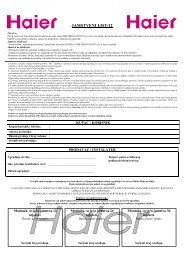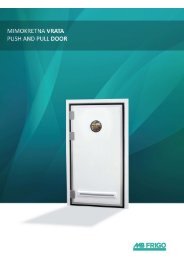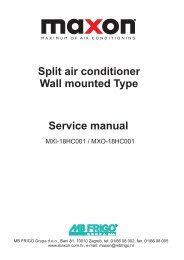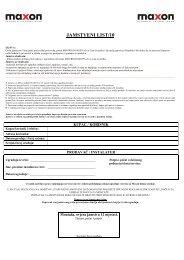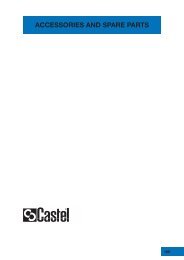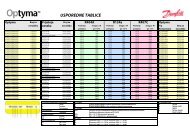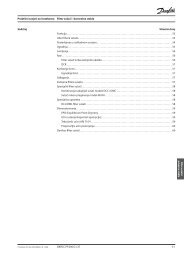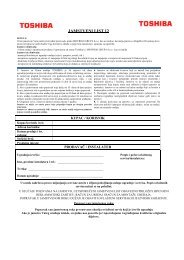Alco Controls
Alco Controls
Alco Controls
- No tags were found...
You also want an ePaper? Increase the reach of your titles
YUMPU automatically turns print PDFs into web optimized ePapers that Google loves.
Pressure <strong>Controls</strong><br />
Basic Terms and Technical Information<br />
Characteristics<br />
Pressure controls serve various functions, which may<br />
be divided into control and protection functions.<br />
Examples for control functions are compressor<br />
cycling, pump-down or defrost control. Protection<br />
functions include, pressure limiting and cut out<br />
against excessive pressures, against loss of charge or<br />
for freeze protection.<br />
These functions are performed by operating a set of<br />
electrical contacts when exceeding a preset lower or<br />
upper pressure limit. Depending on whether they<br />
are type tested (TÜV approved) or not they may be<br />
referred to by the following terms:<br />
without TÜV approval:<br />
with TÜV approval:<br />
Pressure Control<br />
Pressure Limiter,<br />
Pressure Cut Out or<br />
Safety Pressure Cut Out<br />
Pressure controls with TÜV approval are tested<br />
according to EN 12263 as required by DIN 8901 and<br />
EN 378.<br />
1. Pressure controls (without TÜV approval)<br />
Pressure controls without type approval may<br />
either be of the automatic or manual reset type.<br />
Manual reset versions are available for decreasing<br />
(manual reset min.) or increasing pressure<br />
(manual reset max.)<br />
2. Pressure limiters PSL/PSH<br />
Pressure limiters are of the automatic reset<br />
type. Limiters for high pressure applications<br />
have a double bellows design to act as fail-safe<br />
controls.<br />
3. Pressure cut outs PZH/PZL<br />
Pressure cut outs are of the manual reset type<br />
where reset is possible from the outside of the<br />
control without the need for a tool (external<br />
reset). Cut outs for high pressure applications<br />
have a double bellows design to act as fail-safe<br />
controls.<br />
4. Safety pressure cut outs PZHH/PZLL<br />
Pressure cut outs are of the manual reset type<br />
where the reset requires the use of a tool.<br />
Typically, the removal of a cover is required in<br />
order to press the reset button (internal reset).<br />
Cut outs for high pressure applications have<br />
a double bellows design to act as fail-safe<br />
controls.<br />
Adjustment of switching points<br />
A pressure gauge should always be used for<br />
comparison when adjusting the switching points on<br />
pressure controls. The setting scale on the device<br />
is intended to serve for orientation, showing the<br />
setting range of the upper switching point p max<br />
in<br />
bar/psig and the value of the pressure differential ∆p<br />
as difference between upper switching point p max<br />
and<br />
the lower switching point p min<br />
. The upper switching<br />
point p max<br />
has to be adjusted on the scale, whereas<br />
the lower switching point p min<br />
is given by adjustment<br />
of the desired switching differential ∆p.<br />
The formula is:<br />
Upper switching point - Differential =<br />
Lower switching point<br />
Pmax — ∆p = Pmin<br />
Function of contacts SPDT<br />
On pressure rise above setting 1-2 opens and 1-4<br />
closes. On pressure drop below setting 1-2 closes<br />
and 1-4 opens.<br />
SPDT with manual reset max.<br />
On pressure rise above setting 1-2 opens and 1-4<br />
closes and latches. The device can be manually reset<br />
when the pressure has dropped below setting.<br />
Unit of pressure<br />
All pressures are given in gauge pressure<br />
P absolute = P gauge + 1bar<br />
1 bar = 100 kPa<br />
1 bar = 14.5 psi<br />
1<br />
1<br />
SPDT with manual reset min.<br />
On pressure drop below setting 1-2 closes, 1-4 opens<br />
and latches. The device can be manually reset when<br />
the pressure has risen above setting.<br />
1<br />
Pulsation damping<br />
All high pressure controls with A-connection<br />
( 7 / 16 -20UNF, ¼” SAE male) are equipped with a<br />
snubber to protect the pressure element from<br />
pulsations.<br />
P<br />
P<br />
P<br />
+<br />
-<br />
+<br />
-<br />
+<br />
-<br />
4<br />
2<br />
4<br />
2<br />
4<br />
2<br />
104 A2.5.1/0706/E



